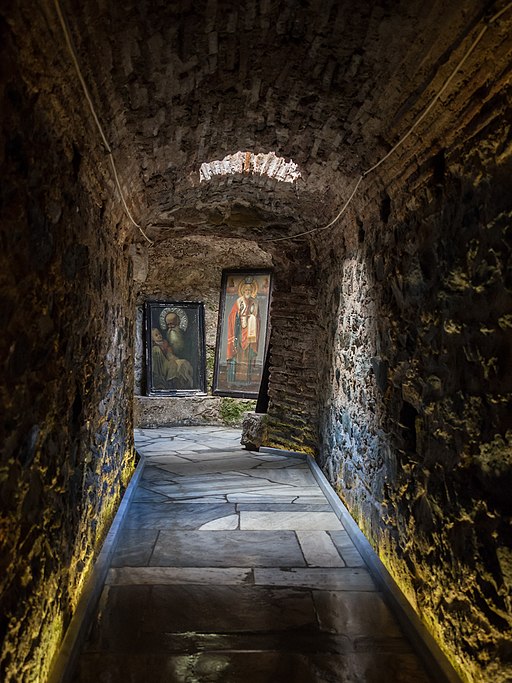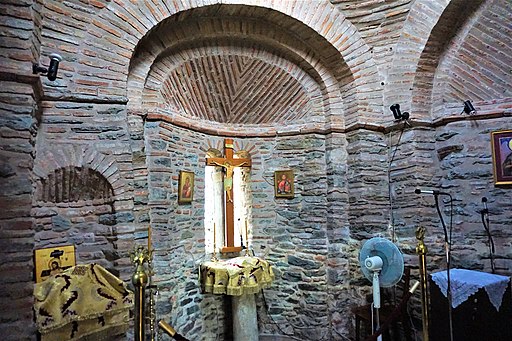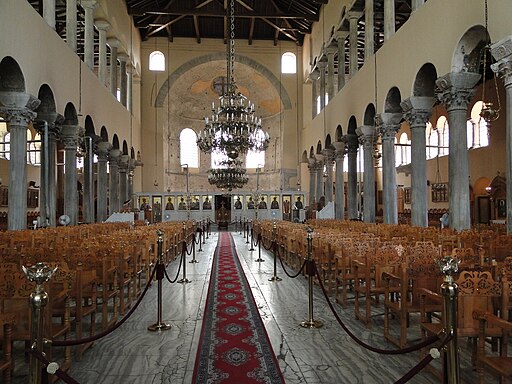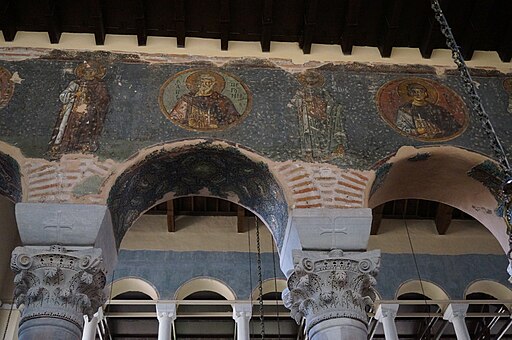
In 379, the Edict of Thessalonica made Christianity the state religion of the Roman Empire. By the time of the Fall of Rome in 476, Thessaloniki was the second-largest city of the Eastern Roman Empire.
In the Byzantine Empire, Thessaloniki was considered the second city in the Empire after Constantinople. The city held this status until its transfer to Venetian control in 1423. In the 14th century, the city’s population exceeded 100,000, making it larger than London at the time.
A Tour of Early Christian and Byzantine Churches
- Catacombs of St. John the Baptist
- Church of Metamorphosis tou Sotiros
- Church of the Acheiropoietos
Catacombs of St. John the Baptist

The Catacombs of St. John the Baptist are hidden from view, in one of the most crowded areas of Thessaloniki, because they are located nearly 5 meters below the street level. The submerged site hosts the ancient Monastery and the Catacombs of Saint John. In the gardens of the catacombs, are the ruins of an ancient nymphaeum. The nymphaeum was centered on a spring dedicated to the nymphs. The later thermal baths date from Roman times. The pagan nymphaeum was converted into a holy water spring during the Christian times, and an underground church and monastery were built there in honor of St. John the Baptist.
A Tour of the Catacombs of St. John the Baptist

The Catacombs of St. John the Baptist are located south of the Church of Hagia Sophia, and today the catacombs still retain their original structure with stairs that lead you even deeper into the ancient catacombs. Before being used by Christians as a religious sanctuary, it is believed that the tunnels were part of an extended aqueduct system built during the Roman era. Archaeological evidence suggests an even earlier use of the site as a pagan temple devoted to ancient deities.

The underground site of the Crypt was initially built during Roman times as part of a bathing complex and later converted to a Crypt and used as a place of worship by the early Christians of Thessaloniki. According to tradition, Saint Dimitrios was imprisoned here and died in 303 A.D. The crypt is a well-preserved because it became lost and unknown for many centuries until it was re-discovered after the Great Thessaloniki Fire of 1917, that devastated the city center.
![]()
These catacombs, like others in the ancient world, may have been connected to a more extensive underground network of tunnels that once existed beneath the city that were destroyed or remain forgotten. Tunnels like these were created for defensive purposes and date back to an ancient period of Thessaloniki’s history.

Nymphaeum
A nymphaeum in ancient Greece and Rome was a monument consecrated to the nymphs and usually located near natural springs. These monuments were built on natural grottoes, which tradition assigned as habitations to the local nymphs. They supplied a stable water source.
Catacombs of St. John the Baptist
- Name: Catacombs of St. John the Baptist or Catacomb of Agios Ioannis
- City: Thessaloniki
- Country: Greece
- Date: Pagan to Roman to Byzantium Christian
- Type: Historical Site
- Location: Makenzi King, Thessaloniki 546 22, Greece
Church of Metamorphosis tou Sotiros

Church of Metamorphosis tou Sotiros was probably built as a burial church to a Byzantine monastery. The church is a charming little Byzantine church with a high dome in the rare tetraconch architectural style. Constructed in the 14th century, its original form was a square with the dome. The narthex to the west was added during a later period.
Church of Metamorphosis tou Sotiros Tour
Inside the church, the rare frescoes and mural decor are contemporary to the church founding and part of the Paleologan tradition. Paleologan refers to the time when the Byzantine Empire was ruled by the Palaiologoi dynasty in the period between 1261 and 1453 AD, representing the artistic period just before the Fall of Constantinople to the Ottoman Empire.

Narthex
The narthex is an architectural element typical of early Byzantine churches consisting of the entrance or lobby area, located at the west end of the nave, opposite the church’s main altar.

Tetraconch
A tetraconch, from the Greek for “four shells,” as in this example, is a church or with four apses, one in each direction of equal size. The original ground plan of the building is, therefore, a Greek cross. They are most common in Byzantine architecture.

Did you know?
- The name of the church, Metamorphosis tou Sotiros, means the Transfiguration of the Savior.
- A coin was discovered in the dome dating the construction to around 1350.
- Graves were discovered located inside the church, under the roof and surrounding the building, indicating it was used as a sepulchral chapel to a Byzantine monastery.

Transfiguration of Jesus
In Christian teachings, the Transfiguration is a pivotal moment in the story of Jesus. The setting on Transfiguration on the mountain is presented as the point where human nature meets God. The meeting place for the temporal and the eternal, with Jesus as the connecting point, the bridge between heaven and earth.
Many Christian traditions, including the Eastern Orthodox, Roman Catholic, and Anglican churches, commemorate the event as a major festival during the Feast of the Transfiguration.
Church of Metamorphosis tou Sotiros
- Name: Church of Metamorphosis tou Sotiros
- City: Thessaloniki
- Country: Greece
- Date: 1340
- Type: Historical Church Site
- Location: Junction of Egnatias Street & Paleon Patron Germanou Street
Church of the Acheiropoietos

The Church of the Acheiropoietos is a Byzantine church dated from its bricks and mosaics to ca. 450–470, making it one of the earliest of the Thessaloniki’s surviving churches, although it was modified in the 7th and again in the 14th–15th centuries. The building is a three-aisled basilica, some 28 m wide and 36.5 m long, with a wooden roof. The three aisles are separated by columns, while the two side aisles have galleries above them.
The current entrance is through a triple-arched opening that connects the narthex with the central nave. The surviving parts of the church’s original interior decoration include 5th-century Ionian capitals, the green Thessalian marble columns, the original Proconnesian marble pavement of the central nave, and fragments of 5th-century decorative mosaics. Early 13th-century frescoes depicting the Forty Martyrs of Sebaste adorn the southern side. Underneath the north aisle’s current pavement, floor mosaics from a previous Roman-era bath have been uncovered.

Church of the Acheiropoietos Tour
After the Ottoman conquest of the Thessaloniki in 1430, the Acheiropoietos was converted into a mosque by Sultan Murad II. Throughout the Ottoman period, it remained the city’s principal mosque under the name Eski Camii (“Old Mosque”).
Did you know?
- An inscription by Sultan Murad II survives in the northern colonnade, on the eighth column from the east.
- Byzantine sources state that the cult of the city’s patron saint, St. Demetrius, was practiced there.
- The name Church of the Acheiropoietos is presumably after a miraculous acheiropoietos (“not made by hands”) icon of Panagia Hodegetria that was housed in the church.

The current entrance is through a triple-arched opening that connects the narthex with the central nave.

The entranceway, which connected the church with the city’s Byzantine-era thoroughfare.

The surviving parts of the church’s original interior decoration include 5th-century Ionian capitals, the green Thessalian marble columns, the original Proconnesian marble pavement of the central nave, and fragments of 5th-century decorative mosaics.
The building is a three-aisled basilica, some 28 m wide and 36.5 m long, with a wooden roof. The three aisles are separated by columns, while the two side aisles have galleries above them.
Floor mosaics from an earlier Roman-era bath have been uncovered.
Byzantine Mosaics in the Church of the Acheiropoietos
Church of the Acheiropoietos
- Name: Church of the Acheiropoietos
- Greek: Ιερός Ναός Παναγίας Αχειροποιήτου
- City: Thessaloniki
- Country: Greece
- Date: 5th-century
- Type: Historical Church Site
- Location: Agias Sofias street opposite Makedonomachon square
Explore Greek Museums and Historic Sites
- Athens Museums
- Ancient Corinth Museums
- Delos Museums
- Delphi Museums
- Ancient Mycenae Museums
- Epidaurus Museums
- Heraklion, Crete Museums
- Meteora Museums
- Milos Museums
- Mykonos Museums
- Mystras Museums
- Nafplion Museums
- Olympia Museums
- Pella Museums
- Samos Museums
- Santorini Museums
- Thessaloniki Museums
- Vergina Museums
Museums in Athens
- Acropolis Museum
- National Archaeological Museum
- Benaki Museum
- Goulandris Museum of Cycladic Art
- Byzantine and Christian Museum
- Hellenic Motor Museum
- National Historical Museum, Athens
- Museum of the Ancient Agora
- Syntagma Metro Station Archaeological Collection
- Numismatic Museum of Athens
- Athens War Museum
- Jewish Museum of Greece
- Athens University Museum
Athens Historical Sites
- Acropolis of Athens
- Ancient Agora of Athens
- Temple of Olympian Zeus, Athens
- Tomb of the Unknown Soldier, Athens
- Roman Agora
- Temple of Poseidon at Sounion
- Temple of Hephaestus
- Roman Baths, Athens
- Aristotle’s Lyceum
Thessaloniki Museums
- Archaeological Museum of Thessaloniki
- Museum for the Macedonian Struggle (Thessaloniki)
- Atatürk Museum
- War Museum of Thessaloniki
Thessaloniki Historical Sites
- Roman
- Triumphal Arch of Galerius
- Early Christian and Byzantine Monuments
- Ottoman
- Bey Hamam
- Bezesteni Market
- White Tower of Thessaloniki
- Post-Byzantine
- Trigonion Tower
Delphi Museums and Historical Sites
- Delphi Archaeological Museum
- Archaeological Site of Delphi
Delos Museums and Historical Sites
- Archaeological Museum of Delos
Santorini Museums
- Akrotiri Archaeological Site
Olympia Museums and Historical Sites
- Archaeological Museum of Olympia
- Museum of the History of the Olympic Games of Antiquity
- Olympia Archaeological Site
Corinth Museums and Historical Site
- Archaeological Museum of Ancient Corinth
Mycenae Museum and Historic Site
- Archaeological Museum of Mycenae
Epidaurus Museum & Historic Site
- Archaeological Museum of Epidaurus
- Ancient Theater of Epidaurus
Heraklion, Crete Museum & Historic Site
- Knossos Archaeological Site
- Archaeological Musem of Heraklion
Meteora Historic Site
- Meteora Monasteries
Milos Museum & Historic Site
- Milos Museum
Mystras Historic Site
- Fortified Medieval Mystras
Pella Museum & Historic Site
- Archaeological Museum of Pella
~~~
“Rather let the crime of the guilty go unpunished than condemn the innocent.”
– Emperor Justinian I
~~~
Photo Credit: JOM; By Hermann Hammer [CC BY-SA 4.0 (https://creativecommons.org/licenses/by-sa/4.0)], from Wikimedia Commons;By G.Garitan [CC BY-SA 4.0 (https://creativecommons.org/licenses/by-sa/4.0)], from Wikimedia Commons; By Hermann Hammer [CC BY-SA 4.0 (https://creativecommons.org/licenses/by-sa/4.0)], from Wikimedia Commons; JOM; By Vasarchit [CC BY 3.0 (https://creativecommons.org/licenses/by/3.0)], from Wikimedia Commons;By Knop92 [Public domain], from Wikimedia Commons; By G.Garitan [CC BY-SA 4.0 (https://creativecommons.org/licenses/by-sa/4.0)], from Wikimedia Commons
Popular this Week








 Sponsor your Favorite Page
Sponsor your Favorite Page SEARCH Search for: Search Follow UsJoin – The JOM Membership Program
Sponsor a Masterpiece with YOUR NAME CHOICE for $5
Share this:
- Tweet




